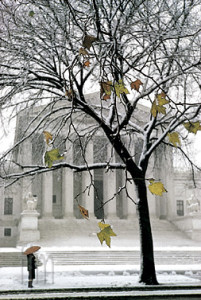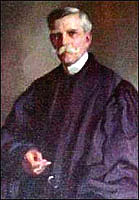First Published in The Washington Post
Test Your Supreme Court Knowledge
By Paul Levine
Research is the bane of most writers, and legal research the bane of lawyers. Countless hours are spent in musty libraries or staring bleary-eyed into the computer screen, or interviewing sources or witnesses. Well, I’m both a writer and lawyer, and I have a confession. I love legal research and general research, too. I love the details, the background, the anecdotes that make any new setting come alive. I love to learn.
First, a definition. According to Wikipedia, “legal research is the process of identifying and retrieving information necessary to support legal decision-making.” It’s what judges, their law clerks, and lawyers do, not always happily.
My novel IMPACT is set at the U.S. Supreme Court, the most majestic and mysterious of our institutions. It’s a closed society with no press conferences or interviews of the Justices or their aides, the equally mysterious young law clerks.
When I practiced law, I held the Supreme Court in awe. The marble palace seemed like a great cathedral, a holy place where our most fundamental rights are secured by towering figures in black robes. What is really behind the mystique? What goes on behind the red velvet drapes and towering pillars? Could a law clerk be compromised by outsiders and steal a Justice’s vote along with his heart? Just how could you fix a case at the highest Court in the land?

Those questions led to a novel about a female law clerk being planted on the Court to sway a Justice’s vote in a multi-million dollar case. But to make the story credible, to make the people and places real, requires research. I spent several months interviewing former clerks and lawyers who have practiced extensively before the Court. I watched oral arguments. I pored through books in the stately law library and even shot buckets on the Justices’ basketball court one floor above the courtroom, truly the “highest court” in the land. (Originally published in hardcover by Simon & Schuster as “9 Scorpions,” the book is now available on Amazon Kindle as IMPACT).
Here is some of what I discovered in the marble corridors and leather-bound volumes of our most magnificent institution. It’s a 20-question quiz designed to test your legal I.Q., but in a lighthearted way. Grade yourself on the honor system. No legal research allowed.
Legal Research: The Supreme Court Quiz
- “Nine scorpions in a bottle.”
- a. Justice William O. Douglas’ favorite tequila drink.
- b. A shorthand term for a landmark case involving an endangered species of lizards.
- c. Justice Oliver Wendell Holmes’ description of his contentious brethren.
- The Supreme Court does not allow its proceedings to be televised because:
- a. The Constitution expressly forbids it.
- b. The Justices fear that grandstanding lawyers would turn the proceedings into a circus that would make the O.J. Simpson trial appear dignified by comparison.
- c. The TV networks have declined to broadcast the hearings on the ground that they’re more boring than “Become-a-real-estate-tycoon” infomercials.
- “We are not final because we are infallible, but we are infallible because we are final.”
- a. Justice Robert Jackson on the power and authority of the Court, in Brown v. Allen, 1953.
- b. Justice William Rehnquist becoming hopelessly confused during oral argument in Bennett v. Spears, 1996.
- c. Justice Clarence Thomas, in refusing to pay for the Tex-Mex fajitas erroneously delivered to his chambers from the Court cafeteria.
- In a 1998 decision, the Supreme Court ruled that a company could be held liable for sexual harassment, even if superiors were not aware of the illegal conduct and even if the victim suffered no job-related harm, as long as:
- a. The victim was a female.
- b. The company failed to make substantial contributions to either the Democratic or Republican national committees.
- c. The victimized employee attempted to use the company’s anti-harassment procedures but to no avail.
- “Marbury versus Madison”
- a. The 1803 decision in which the Court asserted its power to declare statutes unconstitutional.
- b. The game that decided the small college football champion in 2004.
- c. The contenders for the presidency in 1808.
- “Tell the Chief Justice I don’t work for him.”
- a. President Lyndon Johnson, on turning down Chief Justice Earl Warren’s golfing invitation.
- b. Mrs. Warren Burger to her husband when asked to take his judicial robes to the dry cleaner.
- c. Justice James McReynolds’ reply when told he’d been summoned by Chief Justice Charles Evans Hughes.
- The first Chief Justice of the United States Supreme Court.
- a. Judge Judy
- b. John Marshall
- c. John Jay
- “Five votes can do anything around here.”
- a. The angry response from Justice John Paul Stevens when a majority of Justices ordered turkey instead of roast beef for a luncheon buffet.
- b. Justice William Brennan’s remark reflecting awe at the power of the Court on the slimmest of majority votes.
- c. An anonymous quote from a Justice when the Court voted itself a pay raise.
- Engraved above the entrance to the Supreme Court building is the phrase:
- a. “Equal Justice Under Law.”
- b. “All ye who enter here abandon hope.”
- c. “Dura lex sed lex.” (The law is hard, but it is the law).
- “Who is that beast who dares come before us in a grey coat?”
- a. Truman Capote’s barbed question when Chief Justice Warren Burger showed up for a black-and-white party in unsuitable attire.
- b. Justice Horace Gray’s remark in the 1890’s when a young lawyer appeared before the Court without wearing formal “morning clothes.”
- c. Oscar’s Wilde’s unflattering description of the judge who presided over his morals trial.
- Before each oral argument, the Justices traditionally:
- a. draw straws to determine who will ask the first question.
- b. sip brandy and take a short nap.
- c. shake each other’s hands in a show of collegiality.
- “I could never succeed in intelligibly [defining pornography], but I know it when I see it.”
- a. Justice Potter Stewart in Jacobellis v. Ohio, 1964.
- b. Woody Harrelson in The People versus Larry Flynt.
- c. Anonymous grand juror who sneaked a peak at the handwritten doodles in Special Prosecutor Kenneth Starr’s notepad.
- Of the following, who is not depicted in a marble sculpture portraying lawgivers on the Supreme Court building?
- a. Moses
- b. Confucius
- c. Alan Dershowitz
- A marble figure on the back of the courtroom wall depicts a winged female figure representing:
- a. Janet Reno
- b. Divine Inspiration
- c. Drew Barrymore, in “Charlie’s Angels” gear.
- When the ornate Supreme Court building was finished in 1935, Justice Harlan Fiske Stone called it:
- a. “bombastically pretentious”
- b. “fit for Solomon or Charlemagne”
- c. “cold and drafty”
- You enter the Supreme Court building:
- a. through revolving doors, hence the term, “revolving door justice.”
- b. through giant brass doors engraved with historical scenes.
- c. only after being strip-searched.
- “Nine old men” refers to:
- a. The Boston Red Sox, the favorite team of Justice David Souter.
- b. The plaintiffs in the largest age discrimination case to come before the Court.
- c. President Franklin Roosevelt’s pejorative term for the Court which held unconstitutional much of his New Deal legislation.
- “The great moral substitute for force in controversies between the people, the states and the union” refers to:
- a. contingency fee lawyers
- b. The Supreme Court of the United States
- c. William Shatner in “Boston Legal”
- Engraved above the bench in the courtroom are the words:
- a. “Order in the Court”
- b. Nothing, as the architect determined that the Court speaks for itself and needed no slogan.
- c. “Jus est ars boni et aequi.” (The law is the art of the good and the just).
- The President appoints Supreme Court Justices, but under the Constitution, the appointment must be approved by:
- a. Both chambers of Congress.
- b. Only the Senate
- c. The President’s spouse

Oliver Wendell Holmes, Jr.
Test Your Legal I.Q. Answers
1-c; 2-b; 3-a;4-c;5-a;6-c;7-c;8-b;9-a;10-b;11-c;12-a;13-c;14-b;15-a;16-b;17-c;18-b;19-b;20-b.
GRADING SYSTEM
Correct Answers Legal Position
19-20………………………………Chief Justice
16-18………………………………Associate Justice
12-15………………………………Politically Appointed Trial Judge
10-11………………………………Shyster Lawyer (Do more legal research!)
9 and Below…………………….Law School Dropout
(Visit my Amazon Author Page for all my books or my Website Home Page or go directly to IMPACT, my Supreme Court thriller. So many options!)